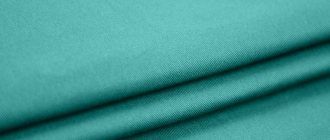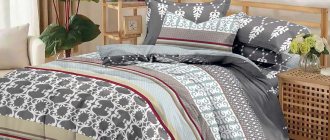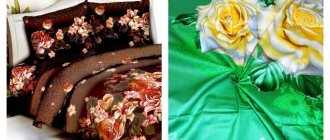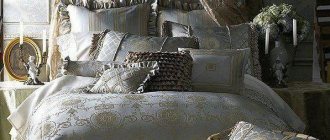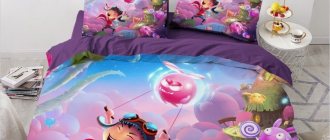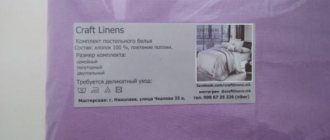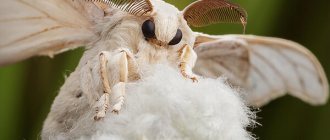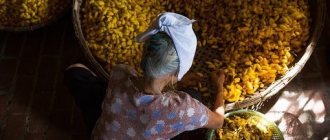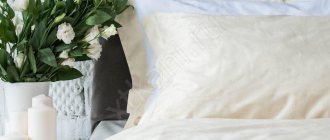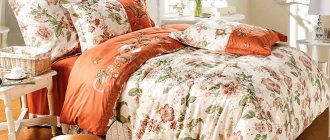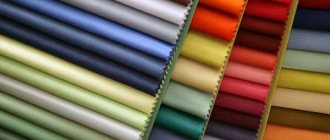Home / By weaving type
Back
Published: 12/03/2020
Reading time: 4 min
1
207
Satin fabric has a noble shine and incredible strength. Made primarily from cotton. Due to the natural origin of the fibers, the material is not much inferior to natural silk, and in terms of performance characteristics it surpasses traditional fabrics.
- 1 Appearance and characteristics
- 2 Production features
- 3 Classification 3.1 By composition
- 3.2 By method of drawing
- 3.3 By purpose
Appearance and characteristics
The history of satin is lost in the mists of time, but it is known that already in the medieval Middle Kingdom weavers created dense fabric with a characteristic shine. The secret of its production, like silk, remained unsolved for a long time.
Satin came to Europe in the 12th century, thanks to Arab merchants. They also gave the material a name. The fact is that textiles were mainly exported from the Chinese city of Quanzhou, which sounds like Zaytun in Arabic. In France, the name was finally transformed into satin, surviving to this day.
The fabric was originally made from silk, so it was extremely expensive. Attempts to make satin cheaper were crowned with success when some of the fibers began to be replaced with cotton, and then with artificial and synthetic threads. The appearance has remained virtually unchanged, but strength and durability have increased.
Satin fabric has a smooth, silky surface on the front side and a slightly rough back. It has a characteristic soft shine, thanks to thin and tightly twisted weft threads, as well as the weaving technique of the same name.
Customer reviews about the kits
Products made from this material cause a lot of conflicting reviews. According to the owners of budget models, the quality remains low. Accessories quickly fail and lose their characteristic shine and strength. However, the price allows you to purchase several replacement sets. Such alternation not only diversifies the bedroom set. The frequency of washing is reduced, which leads to an increase in service life.
Reviews of premium satin bed linen are mostly positive. Users highlighted the strength, wear resistance and color saturation. Even after numerous washes it retains its noble appearance.
Along with quality, comfort is indicated. Natural air circulation creates favorable conditions for restful sleep. The sheet does not need to be secured; the soft fleecy surface is firmly held on the mattress.
Production Features
Many enterprises around the world are engaged in the production of satin. In addition to the Russian Federation, it is produced in China, Italy, Pakistan, and India. A significant part of the market is occupied by Turkish satin, from which luxury bed and table linens are made. However, there is no fundamental difference in the production process; the technologies are approximately the same for everyone.
The raw material for natural fabric is cotton: regular or mercerized. The process involves treating natural fiber with a solution of sodium hydroxide. Under the influence of alkali, the structure of cellulose changes, acquiring the properties of viscose: the fiber becomes voluminous, the pile is smoothed.
The yarn gains shine, strength and tear resistance increases. The treated fibers are then woven into cloth, which is then bleached and dyed. Satin with mercerized fibers responds better to pigments.
Another feature of textiles is satin weave, which is made with at least 5 threads: 4 weft threads covering 1 warp fiber. In each subsequent row, the rapport shifts by 1-2 steps, forming a kind of pattern. The front surface is smooth and shimmering due to the thin, tightly twisted threads, while the back surface is more matte, reminiscent of flannel.
Which fabric is better for bed linen?
There are many different fabrics that are made from the fibers described above. Below are the main types suitable for sewing bedding.
Satin
Satin is a luxury fabric. The soft material is sometimes called "cotton silk". Two types of cotton thread are used to make satin. One of them - rough, dense and matte - serves as a solid base. The other - shiny and very thin - forms a smooth front surface. Satin has the following characteristics:
- does not wrinkle;
- has high thermal conductivity;
- characterized by long-term operation;
- does not cause slipping, despite its smoothness;
- has high wear resistance;
- has a high cost.
Calico
This type of underwear is chosen by those who value durability and ease of care. Dense fabric is created by a simple plain weave, due to which it acquires high strength. Basic properties of calico:
- withstands many washes;
- tolerates exposure to bleaches;
- does not shrink;
- absorbs moisture;
- characterized by hypoallergenicity;
- protects against cold;
- does not shed;
- protects against pathogenic bacteria;
- has roughness;
- considered coarser than satin.
Poplin
The fabric is durable and strong, but much thinner than calico, softer and more pleasant to the touch. This is achieved due to the weaving features. Fine and smooth fibers completely entwine coarse and thick threads, forming a transverse scar. Poplin has the following properties:
- has smoothness, softness;
- does not require ironing;
- does not wrinkle;
- has excessive thinness (sometimes the blanket and pillow are visible through the fabric).
Chintz
Chintz is a type of cotton fabric. The material is created with a simple plain weave, due to which the fabric is low in cost. And if you are interested in the question: which fabric is better for children's bedding, then all pediatricians will assure you - chintz. This material is recommended for use in making diapers for infants and newborns. The fabric has the following advantages:
- completely natural composition;
- high environmental friendliness;
- hypoallergenic;
- high moisture absorption;
- hygroscopicity;
- presence of shrinkage;
- fragility.
Batiste
Cotton and flax fibers are used to make cambric. Accordingly, the fabric combines their common properties. The material is obtained using a plain weave of thin twisted threads. Basic properties of cambric:
- silkiness;
- softness;
- subtlety;
- hygroscopicity;
- strength;
- hypoallergenic.
The fabric does not tolerate high temperatures. Therefore, it is recommended to wash the product manually, at temperatures not exceeding 30ºC. Do not expose laundry to bleaching agents.
Percale
A fabric with the unusual name percale is used in the aviation industry. Sails are made from it. And it is percale (though household, not technical) that is used for sewing bedding sets. The peculiarity of this fabric is its cross-shaped weaving, which creates high strength. The raw material for percale is cotton fiber. Sometimes they are combined with linen or polyester. Linen made from percale is soft, smooth, and has a certain velvety feel. Main characteristics of the fabric:
- withstands long-term use;
- does not shrink;
- has high breathability;
- does not shed;
- is environmentally friendly and hypoallergenic;
- does not cause difficulties in care.
So, which material is better for bed linen - satin, calico, cambric or percale? There is simply no single solution. Therefore, focus on your preferences and budget.
Video on the topic
Classification
Today there is a wide variety of satins. All of them can be classified according to several criteria.
By composition
If previously the material was made exclusively from silk or cotton, now many other fabrics have appeared.
| Name | Compound |
| Regular satin | 100% cotton |
| Double-satin | Cotton with viscose added |
| Crepe satin | Natural/rayon silk with viscose or polyester |
| Mako-satin | 100% high quality long staple Egyptian cotton |
| Microsatin | 1 option: cotton + polyester; Option 2: 100% polyester |
| Novosatin | 100% synthetic |
| Satin-satin | Cotton combined with silk fibers |
| Satin blend | Cotton with synthetics (usually with polyester) |
| Satin Deluxe | Completely natural composition, high-density fabric – 120 g/m2 (regular satin – 86 g/m2) |
| Software | Insulated satin made of microfibers treated with impregnation creating a flannel effect |
| Polysatin | Cotton with polyester or 100% synthetic |
| Silk-satin | Silk on the front side, cotton on the back |
| Staple satin | Cotton with lavsan |
According to the method of drawing
In the manufacture of fabrics, different dyeing techniques are used, thanks to which today there is a huge selection of satins.
They can be divided into several main groups:
Author:
Anastasia Kukushkina
I hope you enjoy the article I have prepared for you! If you find errors in it, write to me about it! I will answer any questions you have, ask them!
